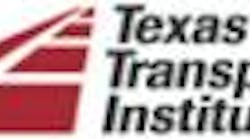"There is no rigid prescription – no 'best way' – to address congestion problems. The most effective strategy is one where agency actions are complemented by efforts of businesses, manufacturers, commuters and travelers. Each region must identify the projects, programs and policies that achieve goals, solve problems and capitalize on opportunities." –Tim Lomax, researcher with the Texas Transportation Institute (TTI) at Texas A&M University, from TTI’s 2010 Urban Mobility Report
There’s a lot of traffic out there on them thar roads – and, once again, we’ve got a big, detailed report to prove it.
The 2010 Urban Mobility Report, published by the Texas Transportation Institute (TTI) at Texas A&M University, paints a pretty grim picture (as it always does) of the traffic congestion clogging up America’s roadways.
Consider these statistics, for starters: The top 15 urban areas in the U.S. out of 439 studied by TTI account for 55% of the traffic delays that occurred in 2009, with the top 20 areas accounting for over 65% of those annual delays.
Here are some others: in 2009, congestion (based on wasted time and fuel) cost about $115 billion in the 439 urban areas, compared to $113 billion (in constant dollars) in 2006 and $24 billion in 1982 (the first year researched by TTI when it began publishing these disheartening traffic studies in 1984).
[Here’s how one state transportation department is trying to combat traffic congestion and delays – through what’s been dubbed “active traffic management.”]
TII also found that the average cost per auto commuter in the 439 urban areas due to traffic congestion declined slightly to $808 in 2009 from $817 in 2008 (using constant dollars).
Yet the range of costs proved wider – from an average of $1,166 per auto commuter in what TTI calls “very large” urban areas down to $436 per auto commuter in “small areas,” though the drop is mainly attributed to the poor economic conditions of the last few years, said TTI research Tim Lomax – noting that congestion delays cost commuters just $351 in 1982.
“The recession has helped some of us forget about our national traffic problem, but the recovery should help us remember it,” he said. “After two years of slight declines in overall traffic congestion – attributable to the economic downturn and high fuel prices – leading indicators suggest that as the economy rebounds, traffic problems are doing the same. While 2008 was the best year for commuters in at least a decade, the problem again began to grow in 2009.”
TTI also calculated that the 3.9 billion gallons of fuel wasted in the 439 urban areas due to traffic delays would fill 78 super-tankers, 520,000 gasoline tank trucks, or 130 days worth of throughput from the Alaskan oil pipeline.
The urban areas with populations greater than 3 million accounted for 1.6 billion gallons (about 55% of the national estimate) of wasted fuel, with the amount of wasted fuel per auto commuter ranging from 39 gallons per year in the very large urban areas down to 16 gallons annually in small areas, the group found.
Yearly peak delays for the average commuter topped 34 hours in 2009, up from 14 hours in 1982, but without public transportation services, TTI said it would be much worse as travelers would have suffered an additional 785 million hours of delay and consumed 640 million more gallons of fuel – a savings of $19 billion in congestion costs. Roadway operational treatments save travelers 320 million hours of delay and 265 million gallons of fuel for a congestion cost savings of $8 billion, the group added.
TTI added that it’s improved the methodology used to calculate congestion more than a dozen times since it first started publishing these mobility reports nearly threedecades ago, but the changes made possible by access to hour-by-hour speed data are the most significant improvement yet, researchers say.
"This year's report is a remarkable game changer," TTI researcher David Schrank explained. "The new data address the biggest shortcoming of previous reports. The data show conditions for every day of the year and include the effect of weather problems, traffic crashes, special events, holidays, work zones and other factors directly impacting traffic flow."
As a result of the new data tracking methods, three new measures of congestion are calculated for the 2010 report: delay per auto commuter, delay per non-peak traveler, and a Commuter Stress Index (CSI), which is calculated for the worst direction in each peak period to show the time penalty to those who travel in the peak direction.
In general, TTI’s report indicates traffic congestion is worse in the larger urban areas than in the smaller ones (oh, really? I never would have guessed), with traffic congestion levels increasing in every area since 1982.
Congestion extends to more time of the day, more roads, affects more of the travel and creates more extra travel time than in the past, with congestion levels rising in all size categories, indicating that even the smaller areas are not able to keep pace with rising demand.
The need for attention to transportation projects is illustrated in these trends, TTI added, with major projects or programs requiring a significant planning and development time – 10 years is not an unrealistic timeframe to go from an idea to a completed project or to an accepted program. And recent growth rates indicate the urban area average congestion values will jump to the next highest classification – with medium areas in 2019 suffering the congestion problems faced by large areas in 2009.
Not exactly chipper information, is it, for folks like truckers who depend on roadways relatively free of delays in order to get freight delivered on time.



